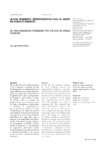Mostrar o rexistro simple do ítem
M. Paul Friedberg: Escenografías para el juego en hábitats urbanos
| dc.contributor.author | Tuset Davó, Juan José | |
| dc.date.accessioned | 2019-11-19T08:14:07Z | |
| dc.date.available | 2019-11-19T08:14:07Z | |
| dc.date.issued | 2019 | |
| dc.identifier.citation | Tuset Davó, J. (2019). M. Paul Friedberg. BAc Boletín Académico. Revista De investigación Y Arquitectura contemporánea, 9, 23-44. https://doi.org/10.17979/bac.2019.9.0.4638 | es_ES |
| dc.identifier.issn | 0213-3474 | |
| dc.identifier.uri | http://hdl.handle.net/2183/24332 | |
| dc.description.abstract | [Resumen] En los años 60 en la ciudad de Nueva York, el arquitecto del paisaje M. Paul Friedberg renovó los emplazamientos de juego infantil, de una manera personal y particular a partir de la observación de la algarabía de los niños y el dinamismo de la gente al usar la calle y la plaza. El artículo resalta su concepto de playground que ofrece diferentes estilos de juego, movimientos impredecibles y dinámicas de comportamiento, que le permitieron explorar la forma arquitectónica y el paisaje del área de recreo infantil. La incorporación de todo un conjunto de construcciones auxiliares facilitadoras del juego daba lugar a imaginar otras posibilidades del espacio público. Estas áreas de juego resultaron ser escenografías en hábitats urbanos, donde la interacción y yuxtaposición de arquitecturas elementales creaban entornos de aprendizaje, descubrimiento y desarrollo personal en los que el tiempo de la fiesta resultaba del uso libre del espacio. | es_ES |
| dc.description.abstract | [Abstract] In the 60s, the landscape architect M. Paul Friedberg renewed the playgrounds for children in a personal and particular way in New York City. For this renewal, he founded on the observation of the children’s excitement and the dynamism of the people when using the street and the square. The article highlights his concept of playground that offers different play styles, unpredictable movements and behavioural dynamics, which allowed him to explore the landscape and the architectural form of the children’s play spaces. The adding of a complete set of auxiliary facilities to promote the play led to imagine other possibilities of public space. These play areas turned out to be sceneries in urban habitats, where the interaction and juxtaposition of elementary architectures created environments of learning, discovery and personal development in which the time of the party resulted from the free use of space | es_ES |
| dc.language.iso | eng | es_ES |
| dc.language.iso | spa | es_ES |
| dc.publisher | Universidade da Coruña | es_ES |
| dc.relation.uri | https://doi.org/10.17979/bac.2019.9.0.4638 | es_ES |
| dc.rights | Atribución-SinDerivadas 4.0 España | es_ES |
| dc.rights.uri | http://creativecommons.org/licenses/by-sa/3.0/es/ | * |
| dc.subject | Parque de juegos | es_ES |
| dc.subject | Parque de aventuras | es_ES |
| dc.subject | Arquitectura del paisaje | es_ES |
| dc.subject | Espacio público | es_ES |
| dc.subject | Nueva York | es_ES |
| dc.subject | Playground | es_ES |
| dc.subject | Adventure playground | es_ES |
| dc.subject | Landscape architecture | es_ES |
| dc.subject | Public space | es_ES |
| dc.subject | New York | es_ES |
| dc.title | M. Paul Friedberg: Escenografías para el juego en hábitats urbanos | es_ES |
| dc.title.alternative | M. Paul Friedberg: Sceneries for th play in urban habitats | es_ES |
| dc.type | info:eu-repo/semantics/article | es_ES |
| dc.rights.access | info:eu-repo/semantics/openAccess | es_ES |
| UDC.journalTitle | Bac Boletín Académico. Revista de investigación y arquitectura contemporánea | es_ES |
| UDC.volume | 9 | es_ES |
| UDC.startPage | 23 | es_ES |
| UDC.endPage | 44 | es_ES |






